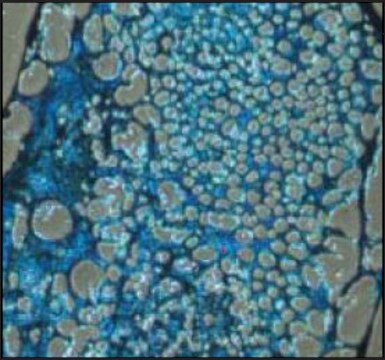K0514
Anti-KCNK9 (TASK-3) antibody, Mouse monoclonal
clone KCN-75, purified from hybridoma cell culture
About This Item
Produtos recomendados
fonte biológica
mouse
Nível de qualidade
conjugado
unconjugated
forma do anticorpo
purified from hybridoma cell culture
tipo de produto de anticorpo
primary antibodies
clone
KCN-75, monoclonal
forma
buffered aqueous solution
peso molecular
antigen ~40 kDa (representing the KCNK9 monomer, and a weaker band at 80 kDa representing the KCNK9 dimer)
reatividade de espécies
human
técnica(s)
immunocytochemistry: suitable
indirect ELISA: suitable
microarray: suitable
western blot: 4-8 μg/mL using whole extract of cultured T-47D cells (human breast carcinoma)
Isotipo
IgG2b
nº de adesão UniProt
Condições de expedição
dry ice
temperatura de armazenamento
−20°C
modificação pós-traducional do alvo
unmodified
Informações sobre genes
human ... KCNK9(51305)
Categorias relacionadas
Descrição geral
Imunogênio
Aplicação
- immunoblotting
- immunohistochemistry
- immunocytochemistry
Ações bioquímicas/fisiológicas
forma física
Exoneração de responsabilidade
Não está encontrando o produto certo?
Experimente o nosso Ferramenta de seleção de produtos.
Código de classe de armazenamento
10 - Combustible liquids
Classe de risco de água (WGK)
nwg
Ponto de fulgor (°F)
Not applicable
Ponto de fulgor (°C)
Not applicable
Certificados de análise (COA)
Busque Certificados de análise (COA) digitando o Número do Lote do produto. Os números de lote e remessa podem ser encontrados no rótulo de um produto após a palavra “Lot” ou “Batch”.
Já possui este produto?
Encontre a documentação dos produtos que você adquiriu recentemente na biblioteca de documentos.
Nossa equipe de cientistas tem experiência em todas as áreas de pesquisa, incluindo Life Sciences, ciência de materiais, síntese química, cromatografia, química analítica e muitas outras.
Entre em contato com a assistência técnica






